The Cause of Extreme Weather Events
Commodities / Climate Change Dec 08, 2012 - 07:28 AM GMTBy: Richard_Mills
 Over the last few months we have been witness to many extreme weather events - heat waves, Europe suffering from a severe cold snap, the worst in twenty five years, extreme flooding in Australia, Brazil and China, to drought in the U.S. Many say the cause is global warming, and lay the blame squarely on greenhouse gas emissions caused by human activity.
Over the last few months we have been witness to many extreme weather events - heat waves, Europe suffering from a severe cold snap, the worst in twenty five years, extreme flooding in Australia, Brazil and China, to drought in the U.S. Many say the cause is global warming, and lay the blame squarely on greenhouse gas emissions caused by human activity.
Are we, and our activities at fault? What can we look forward to if/as the earth continues to warm?
Cause
The Earth's climate has been continuously changing throughout its history. From ice covering large amounts of the globe to interglacial periods where there was ice only at the poles - our climate and biosphere has been in flux for millennia.
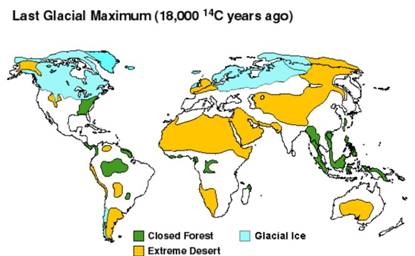
geocraft.com
This temporary reprieve from the ice we are now experiencing is called an interglacial period - the respite from the cold locker began 18,000 years ago as the earth started heating up and warming its way out of the Pleistocene Ice Age.
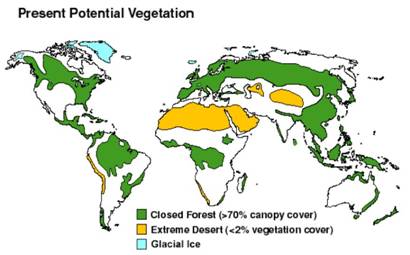
geocraft.com
Approximately every 100,000 years or so our climate warms up temporarily.

These interglacial periods usually last somewhere between 15,000 to 20,000 years before another ice age starts. Presently we're at year 18,000 of the current warm spell.
Serbian astrophysicist Milutin Milankovitch is best known for developing one of the most significant theories relating to Earths motions and long term climate change.
Milankovitch developed a mathematical theory of climate change based on the seasonal and latitudinal variations in the solar radiation received by the Earth from our Sun - it was the first truly plausible theory for how minor shifts of sunlight could make the entire planet's temperature swing back and forth from cold to warm.
Milankovitch's Theory states that as the Earth travels through space around the sun, cyclical variations in three elements of Earth/sun/geometry combine to produce variations in the amount of solar energy that reaches us. These three elements are:
- Variations in the Earth's orbital eccentricity - the shape of the orbit around the sun, a 100,000 year cycle
- Changes in obliquity or tilt of the earth's axis - changes in the angle that Earth's axis makes with the plane of Earth's orbit, a 41,000 year cycle
- Precession - the change in the direction of the Earth's axis of rotation, a 19,000 to 23,000 year cycle
These orbital processes are thought to be the most significant drivers of ice ages and, when combined, are known as Milankovitch Cycles.
Other Climate Change Drivers:
- Changes occurring within the sun affects the intensity of sunlight that reaches the Earth's surface. These changes in intensity can cause either warming - stronger solar intensity - or cooling when solar intensity is weaker.
- Volcanoes often affect our climate by emitting aerosols and carbon dioxide into the atmosphere. Aerosols block sunlight and contribute to short term cooling, but do not stay in the atmosphere long enough to produce long term change. Carbon dioxide (CO2) has a warming effect. For about two-thirds of the last 400 million years, geologic evidence suggests CO2 levels and temperatures were considerably higher than present. Each year 186 billion tons of carbon from CO2 enters the earth's atmosphere - six billion tons are from human activity, approximately 90 billion tons come from biologic activity in earth's oceans and another 90 billion tons from such sources as volcanoes and decaying land plants
These climate change "drivers" often trigger additional changes or "feedbacks" within the climate system that can amplify or dampen the climate's initial response to them:
- The heating or cooling of the Earth's surface can cause changes in greenhouse gas concentrations - when global temperatures become warmer, CO2 is released from the oceans and when temperatures become cooler, CO2 enters the ocean and contributes to additional cooling. During at least the last 650,000 years, CO2 levels have tracked the glacial cycles - during warm interglacial periods, CO2 levels have been high and during cool glacial periods, CO2 levels have been low
- The heating or cooling of the Earth's surface can cause changes in ocean currents. Ocean currents play a significant role in distributing heat around the Earth so changes in these currents can bring about significant changes in climate from region to region
In 1985 the Russian Vostok Antarctic drill team pulled up cores of ice that stretched through a complete glacial cycle. During the cold period of the cycle CO2 levels were much lower than during the warm periods before and after. When plotted on a chart the curves of CO2 levels and temperature tracked one another very closely - methane, an even more potent greenhouse gas, showed a similar rise and fall to that of CO2.
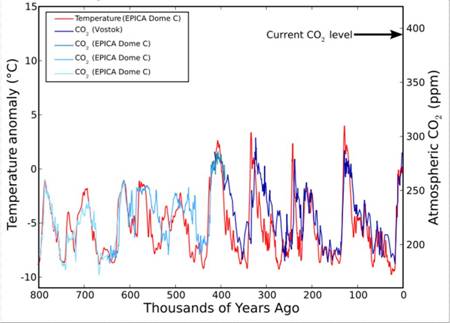
Small rises or falls in temperature - more, or less sunlight - seemed to cause a rise, or fall, in gas levels. Changing atmospheric CO2 and methane levels physically linked the Northern and Southern hemispheres, warming or cooling the planet as a whole. In the 1980s the consensus was that Milankovitch's Cycles would bring a steady cooling over the next few thousand years.
As studies of past ice ages continued and climate models were improved worries about a near term re-entry into the cold locker died away - the models now said the next ice age would not come within the next ten thousand years.
Effect
It's obvious that the orbital changes, as explained by Milankovitch's Theory, initiate a powerful feedback loop. The close of a glacial era comes when a shift in sunlight causes a slight rise in temperature - this raises gas levels over the next few hundred years and the resultant greenhouse effect drives the planet's temperature higher, which drives a further rise in the gas and water vapor levels and so on.
The earth will continue to warm, polar ice caps will melt, so will the Greenland ice sheet and most glaciers. More sunlight will be absorbed by the Earth's oceans, causing increased evaporation. Water vapor is a greenhouse gas and amplifies twofold the effects of other greenhouse gases. With Earth's ice gone there will be significantly less sunlight reflected back into space, vast expanses of Arctic tundra will thaw releasing unbelievable amounts of methane, a greenhouse gas twenty times more potent then CO2.
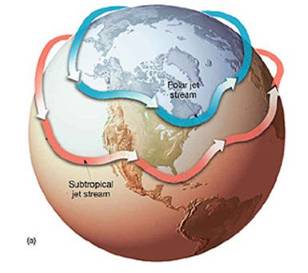
By the end of this century scientists expect our weather to have changed substantially. Because of increased average global temperatures the tropical rain belt will have widened considerably and the subtropical dry zones will have pushed pole-ward, crawling deep into regions such as the American Southwest and southern Australia, which will be increasingly susceptible to prolonged and intense droughts.
The polar jet stream has already been altered, wide swinging north-south deviations (meanders) have become the norm - deviating far from its normal path and meandering north into Canada, the jet stream brings warm air while dipping far south over Europe, the polar jet stream brings record cold and snow.
Ocean currents will be altered, further impacting our climate, and sea levels will rise. Freshwater aquifers will suffer from saltwater intrusion, once habitable zones will become uninhabitable,
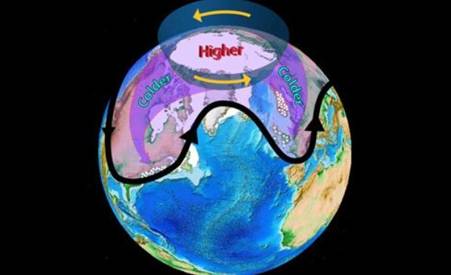
As the meanders meander extreme weather follows
Conclusion
According to science the world is going to continue to get warmer, cyclical variations in three elements of earth/sun/geometry combined to produce more sunlight reaching the earth. Increased sunlight caused a slight rise in temperature - greenhouse gas levels rose and the resultant greenhouse effect is driving the planet's temperature higher, which drives a further rise in gas levels and so on.
A report by the Intergovernmental Panel on Climate Change (IPCC) concluded that climate change will amplify extreme heat, heavy precipitation, and the highest wind speeds of tropical storms. Extreme weather events are going to happen with increasing frequency, the climate for the area you live in is going to change, regardless of what you/we do. We are all watching and experiencing the events and changes in real time.
We should be talking, we should be discussing how best to prepare ourselves, we should not be wasting resources fighting a battle - greenhouse gas reduction - we can't win. Preparation for the changes we know are coming should be on all our radar screens. Is preparation on your radar screen?
If not, maybe they should be.
By Richard (Rick) Mills
If you're interested in learning more about the junior resource and bio-med sectors please come and visit us at www.aheadoftheherd.com
Site membership is free. No credit card or personal information is asked for.
Richard is host of Aheadoftheherd.com and invests in the junior resource sector.
His articles have been published on over 400 websites, including:
Wall Street Journal, Market Oracle, SafeHaven , USAToday, National Post, Stockhouse, Lewrockwell, Pinnacledigest, Uranium Miner, Beforeitsnews, SeekingAlpha, MontrealGazette, Casey Research, 24hgold, Vancouver Sun, CBSnews, SilverBearCafe, Infomine, Huffington Post, Mineweb, 321Gold, Kitco, Gold-Eagle, The Gold/Energy Reports, Calgary Herald, Resource Investor, Mining.com, Forbes, FNArena, Uraniumseek, Financial Sense, Goldseek, Dallasnews, Vantagewire, Resourceclips and the Association of Mining Analysts.
Copyright © 2012 Richard (Rick) Mills - All Rights Reserved
Legal Notice / Disclaimer: This document is not and should not be construed as an offer to sell or the solicitation of an offer to purchase or subscribe for any investment. Richard Mills has based this document on information obtained from sources he believes to be reliable but which has not been independently verified; Richard Mills makes no guarantee, representation or warranty and accepts no responsibility or liability as to its accuracy or completeness. Expressions of opinion are those of Richard Mills only and are subject to change without notice. Richard Mills assumes no warranty, liability or guarantee for the current relevance, correctness or completeness of any information provided within this Report and will not be held liable for the consequence of reliance upon any opinion or statement contained herein or any omission. Furthermore, I, Richard Mills, assume no liability for any direct or indirect loss or damage or, in particular, for lost profit, which you may incur as a result of the use and existence of the information provided within this Report.
Richard (Rick) Mills Archive |
© 2005-2022 http://www.MarketOracle.co.uk - The Market Oracle is a FREE Daily Financial Markets Analysis & Forecasting online publication.



